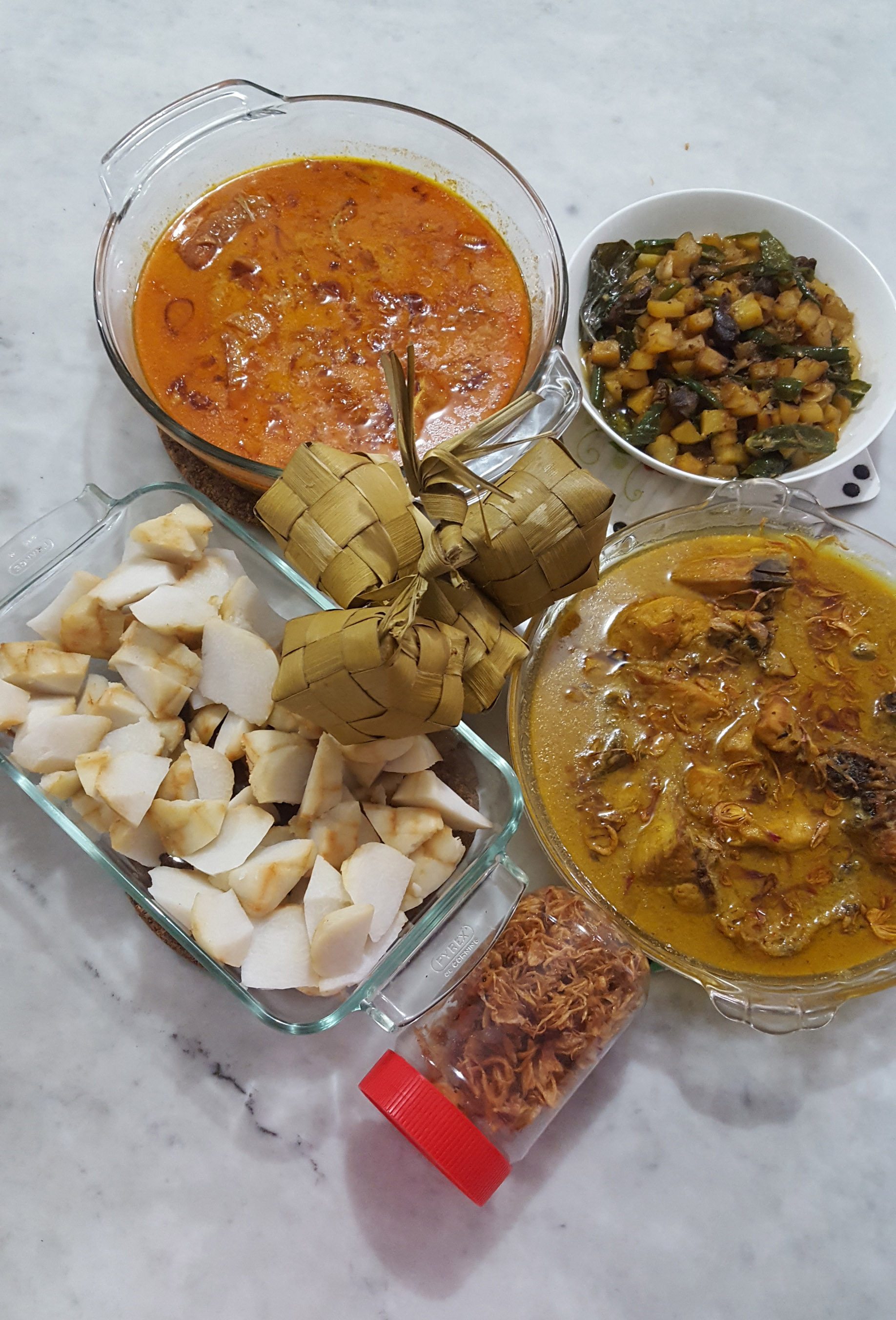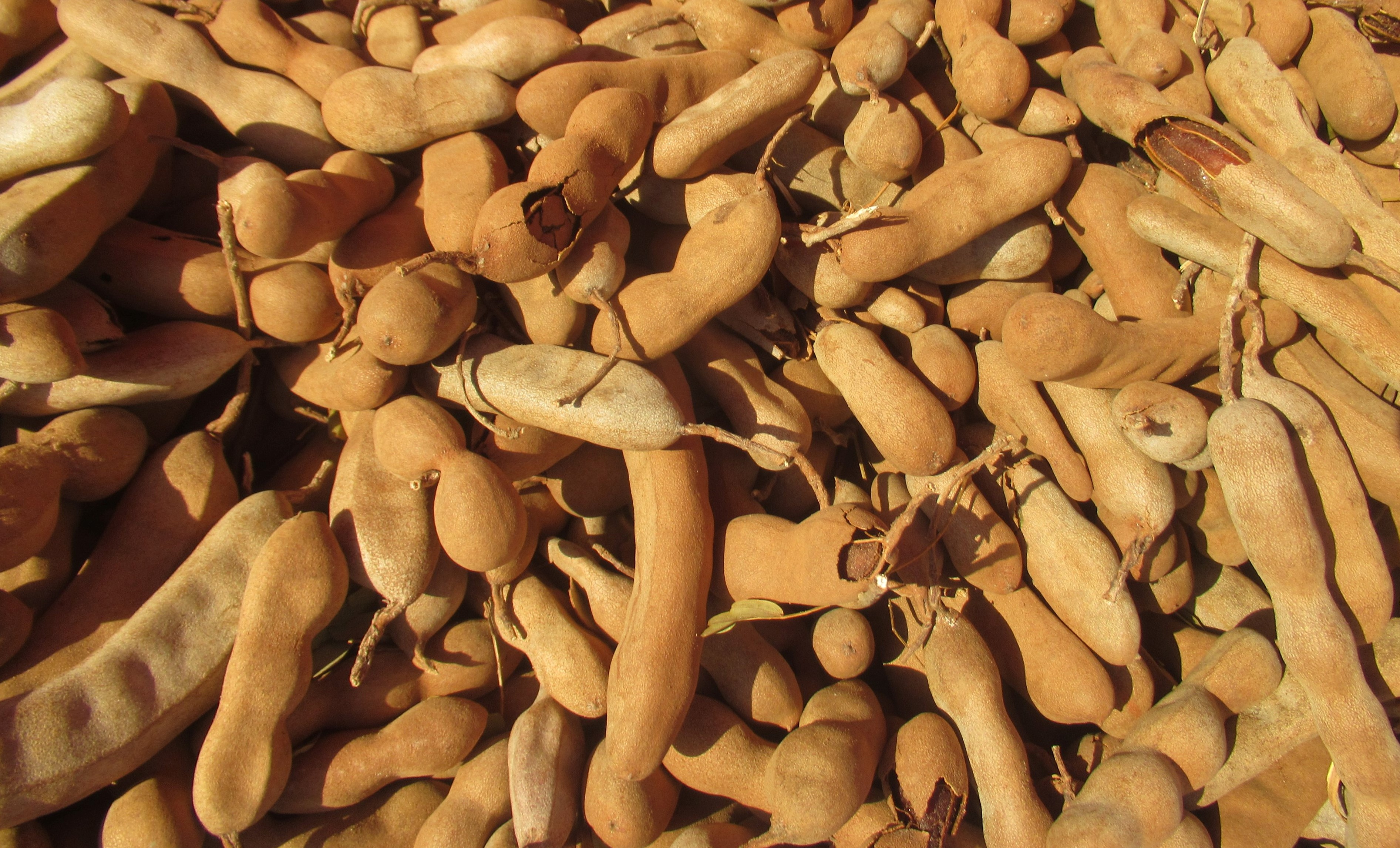|
Urap
''Urap'' (sometimes spelled ''urab'' or in its plural form ''urap-urap'') is a salad dish of steamed or boiled vegetables mixed with seasoned and spiced grated coconut for dressing. It is commonly found in Indonesian cuisine, more precisely Javanese cuisine. ''Urap'' can be consumed on its own as a salad for vegetarian meals or as a side dish. ''Urap'' is usually found as a prerequisite side dish of Javanese ''tumpeng'', a cone-shaped rice mound surrounded with assorted dishes, as well as part of a '' nasi kuning'' dish. In Balinese cuisine, it is known as urab sayur. Ingredients The vegetables which are usually used in ''urap'' are spinach, water spinach, young cassava leaf, papaya leaf, Chinese long beans, bean sprouts, and cabbage. To acquire a rich taste, most recipes insist on using freshly shredded old coconut flesh or ''serundeng'', instead of leftovers. The shredded coconut is seasoned with ground shallot, garlic, red chili pepper, tamarind juice, galangal, salt, and ... [...More Info...] [...Related Items...] OR: [Wikipedia] [Google] [Baidu] |
Javanese Cuisine
Javanese cuisine () is the cuisine of Javanese people, a major Native Indonesian, ethnic group in Indonesia in the provinces of Central Java, Yogyakarta, and East Java. Definition Javanese cuisine refers exclusively to the cuisine of Javanese people, which is often brought to other regions and countries by Javanese diaspora or foreign descents who have lived in Java. There are several native ethnic groups who live on the island of Java (Sundanese people, Sundanese, Madurese people, Madurese, Betawi people, Betawi, etc.) as well as other peoples of foreign descents. In Indonesian language, Javanese refers to people of Javanese ethnic background. Javanese cuisine is thought to be sweet, since this is the taste traditionally preferred in Yogyakarta. However, Javanese regions do not only include Yogyakarta. On the northern and northeastern of Central Java, for instance, the taste tends to be salty and spicy. In East Java, the level of spiciness increases. Today, as Javanese p ... [...More Info...] [...Related Items...] OR: [Wikipedia] [Google] [Baidu] |
Indonesian Cuisine
Indonesian cuisine is a collection of various regional culinary traditions by various ethnic groups that formed in the archipelagic nation of Indonesia. There are a wide variety of recipes and cuisines in part because Indonesia is composed of approximately 6,000 populated List of islands of Indonesia, islands of the total 17,508 in the world's largest archipelago,"Indonesian Cuisine." . Accessed July 2011. Tradition and characteristics Indonesia has around 5,350 traditional recipes, with 30 of them ...[...More Info...] [...Related Items...] OR: [Wikipedia] [Google] [Baidu] |
Lawar (food)
Lawar () is an Indonesian dish created from a mixture of vegetables, coconut, and minced meat mixed with rich herbs and spices, originating from Bali, Indonesia. This dish is commonly found in restaurants and warungs in Bali. Despite its rich vegetable mixture, lawar is not a vegetarian dish, since most often it is mixed with minced meat or even blood. Ingredients Lawar consists of green beans, beaten eggs, vegetable oil, kaffir lime leaves, coconut milk, palm sugar, freshly grated coconut, and fried shallots, all stir-fried in coconut oil. Lawar is named according to its additional protein ingredients, for example, lawar with chicken is called ''chicken lawar'', lawar mixed with pork is called pork lawar. Lawar which uses young jackfruit is called jackfruit lawar. Some types of lawar might add the blood of butchered animals (usually pork or chicken blood) mixed with spices to add taste. Because of its rich protein and fat content acquired from coconut milk and perhaps blood, l ... [...More Info...] [...Related Items...] OR: [Wikipedia] [Google] [Baidu] |
Cassava
''Manihot esculenta'', common name, commonly called cassava, manioc, or yuca (among numerous regional names), is a woody shrub of the spurge family, Euphorbiaceae, native to South America, from Brazil, Paraguay and parts of the Andes. Although a perennial plant, cassava is extensively cultivated in tropical and subtropical regions as an annual crop for its edible starchy tuberous root. Cassava is predominantly consumed in boiled form, but substantial quantities are processed to extract cassava starch, called tapioca, which is used for food, animal feed, and industrial purposes. The Brazilian , and the related ''garri'' of West Africa, is an edible coarse flour obtained by grating cassava roots, pressing moisture off the obtained grated pulp, and finally drying it (and roasting in the case of both and ''garri''). Cassava is the third-largest source of carbohydrates in food in the tropics, after rice and maize, making it an important staple food, staple; more than 500 million pe ... [...More Info...] [...Related Items...] OR: [Wikipedia] [Google] [Baidu] |
Coconut Sugar
Coconut sugar (also known as coco sugar, coconut palm sugar, coco sap sugar or coconut blossom sugar) is a palm sugar produced from the sap of the flower bud stem of the coconut palm. Other types of palm sugar are made from the kithul palm ('' Caryota urens''), Palmyra palm, the date palm, the sugar date palm, the sago palm or the sugar palm. Used as a sweetener in many countries, coconut sugar has no significant nutritional or health benefits over other sweeteners. Manufacture Coconut sugar comes in crystal or granule form, block or liquid. Producing coconut sugar is a two-step process. It starts with harvesting or "tapping" nectar from the flower bud stem of a coconut tree. Farmers make a cut on the spadix and the sap starts to flow from the cut into bamboo containers. The sap collected is then transferred into large woks and placed over moderate heat to evaporate the moisture content of the sap. The sap is translucent and is about 80% water. At this point it is known as ... [...More Info...] [...Related Items...] OR: [Wikipedia] [Google] [Baidu] |
Salt
In common usage, salt is a mineral composed primarily of sodium chloride (NaCl). When used in food, especially in granulated form, it is more formally called table salt. In the form of a natural crystalline mineral, salt is also known as rock salt or halite. Salt is essential for life in general (being the source of the essential dietary minerals sodium and chlorine), and saltiness is one of the basic human tastes. Salt is one of the oldest and most ubiquitous food seasonings, and is known to uniformly improve the taste perception of food. Salting, brining, and pickling are ancient and important methods of food preservation. Some of the earliest evidence of salt processing dates to around 6000 BC, when people living in the area of present-day Romania boiled spring water to extract salts; a salt works in China dates to approximately the same period. Salt was prized by the ancient Hebrews, Greeks, Romans, Byzantines, Hittites, Egyptians, and Indians. Salt became a ... [...More Info...] [...Related Items...] OR: [Wikipedia] [Google] [Baidu] |
Galangal
Galangal () is a rhizome of plants in the ginger family Zingiberaceae, with culinary and medicinal uses originating in Indonesia. It is one of four species in the genus ''Alpinia'', and is known for its pungent, aromatic flavor. Greater galangal (''Alpinia galanga'') is most commonly used, and is similar to ginger and turmeric. It is native to South Asia and Southeast Asia. Lesser galangal (''Alpinia officinarum'') and other types are also used, though less frequently. In traditional medicine, galangal is used to treat various ailments. It is a common ingredient in Thai, Indonesian, and Malaysian cuisine, and is also used in some traditional Chinese medicine. Differentiation The word ''galangal'', or its variant ''galanga'' or archaically ''galingale'', can refer in common usage to the aromatic rhizome of any of four plant species in the Zingiberaceae (ginger) family, namely: * ''Alpinia galanga'', also called ''greater galangal'', ''lengkuas'', ''Siamese ginger'' or ''laos' ... [...More Info...] [...Related Items...] OR: [Wikipedia] [Google] [Baidu] |
Tamarind
Tamarind (''Tamarindus indica'') is a Legume, leguminous tree bearing edible fruit that is indigenous to tropical Africa and naturalized in Asia. The genus ''Tamarindus'' is monotypic taxon, monotypic, meaning that it contains only this species. It belongs to the family Fabaceae. The tamarind tree produces brown, pod-like fruits that contain a sweet, tangy pulp, which is used in cuisines around the world. The pulp is also used in traditional medicine and as a metal polish. The tree's wood can be used for woodworking and #Seed oil and kernel powder, tamarind seed oil can be extracted from the seeds. Tamarind's tender young leaves are used in Indian cuisine, Indian and Filipino cuisine. Because tamarind has multiple uses, it is cultivated around the world in Tropical zone, tropical and Subtropics, subtropical zones. Description The tamarind is a long-living, medium-growth tree, which attains a maximum crown (botany), crown height of . The crown has an irregular, vase-shape ... [...More Info...] [...Related Items...] OR: [Wikipedia] [Google] [Baidu] |
Chilli Pepper
Chili peppers, also spelled chile or chilli ( ), are varieties of berry-fruit plants from the genus ''Capsicum'', which are members of the nightshade family Solanaceae, cultivated for their pungency. They are used as a spice to add pungency (spicy heat) in many cuisines. Capsaicin and the related capsaicinoids give chili peppers their intensity when ingested or applied topically. Chili peppers exhibit a range of heat and flavors. This diversity is the reason behind the availability of different types of chili powder, each offering its own taste and heat level. Chili peppers originated in Central or South America and were first cultivated in Mexico. European explorers brought chili peppers back to the Old World in the late 16th century as part of the Columbian Exchange, which led to the cultivation of multiple varieties across the world for food and traditional medicine. Five ''Capsicum'' species have been widely cultivated: '' annuum'', '' baccatum'', '' chinense'', '' fru ... [...More Info...] [...Related Items...] OR: [Wikipedia] [Google] [Baidu] |
Garlic
Garlic (''Allium sativum'') is a species of bulbous flowering plants in the genus '' Allium''. Its close relatives include the onion, shallot, leek, chives, Welsh onion, and Chinese onion. Garlic is native to central and south Asia, stretching from the Black Sea through the southern Caucasus, northeastern Iran, and the Hindu Kush; it also grows wild in parts of Mediterranean Europe. There are two subspecies and hundreds of varieties of garlic. Garlic has been used for thousands of years as a seasoning, culinary ingredient, traditional medical remedy; it was known in many ancient civilizations, including the Babylonians, Egyptians, Romans, and Chinese, and remains significant in many cuisines and folk treatments, especially across the Mediterranean and Asia. Garlic propagates in a variety of climates and conditions and is produced globally; China is by far the largest producer, accounting for over two thirds (73%) of the world's supply in 2021. Description Garli ... [...More Info...] [...Related Items...] OR: [Wikipedia] [Google] [Baidu] |
Shallot
The shallot is a cultivar group of the onion. Until 2010, the (French red) shallot was classified as a separate species, ''Allium ascalonicum''. The taxon was synonymized with '' Allium cepa'' (the common onion) in 2010, as the difference was too small to justify a separate species. As part of the onion genus ''Allium'', its close relatives include garlic, scallions, leeks, chives, and the Chinese onion. Etymology and names The names '' scallion'' and ''shallot'' are derived from the Old French ''eschalotte'', by way of ''eschaloigne'', from the Latin ''Ascalōnia caepa'' or Ascalonian onion, a ''Ascalōnia caepa'' or Ascalonian onion, a namesake of the ancient city of Ascalon. The term ''shallot'' is usually applied to the French red shallot (''Allium cepa'' var. ''aggregatum'', or the ''A. cepa'' Aggregatum Group). It is also used for the Persian shallot or ''musir'' (''A. stipitatum'') from the Zagros Mountains in Iran and Iraq, and the French gray shallot ('' Allium os ... [...More Info...] [...Related Items...] OR: [Wikipedia] [Google] [Baidu] |
Serundeng
Serundeng () refers to a Javanese spiced grated coconut side dish or condiment originated in Indonesia that is used to accompany rice. Serundeng may taste sweet or hot and spicy, according to the recipe variants. Its best-known variant is an Indonesian preparation of sautéed grated coconut mixed with spice and other ingredients. The spiced shredded toasted coconut can be mixed with peanuts, used as a condiment to add flavour, or used as a garnish sprinkled upon rice-based dishes, such as steamed rice, lontong, ketan sticky rice, and burasa; or upon traditional soto soups. Serundeng can also be considered a separate dish if mixed with main ingredients, such as ''serundeng daging'', which is fried meat, usually beef, served in this serundeng spiced coconut floss. Ingredients Grated coconut flesh forms an essential part of serundeng in Indonesian cuisine. Freshly shredded coconut, instead of grated coconut left over from making coconut milk, gives a richer taste. The coco ... [...More Info...] [...Related Items...] OR: [Wikipedia] [Google] [Baidu] |










